Bouldering is a form of rock climbing that has seen a recent surge in popularity over the last couple of years. Due to this newfound interest, many of those new to the field are wondering how Bouldering and Climbing differ from each other. In this article, we’ll look into exactly that.
Here’s how I would differentiate Bouldering from Roped Climbing:
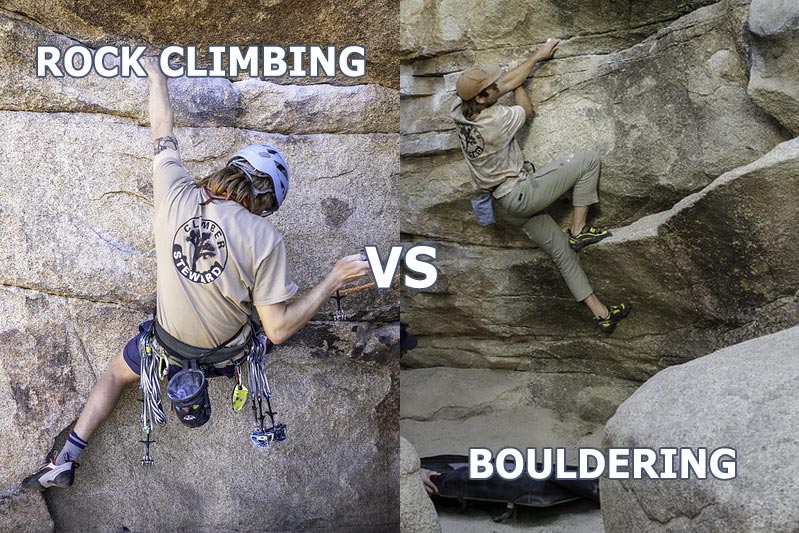
Bouldering is done on smaller rock formations called boulders which are up to 4.5 meters (15) feet in height. Climbing, on the other hand, has no height restrictions because climbers are protected by a rope. Boulderers have no protection from a rope but instead, rely on mats (or crash pads) and sometimes a spotter to break their fall.
Different types of rock climbing
Before we get to comparing rock climbing and bouldering, it will help to understand the different types of rock climbing activities.
- Bouldering: ropeless climbing on small boulders
- Sport Climbing: roped climbing on climbing routes that are typically up to 60 meters high
- Trad Climbing: a more traditional form of rock climbing where the climber carries their gear on their harness and places it during the ascent (and removes it afterward)
- Free Soloing: the dangerous act of climbing long routes without a rope or safety net
- Aid Climbing: climbing using mostly equipment instead of limbs
What is Bouldering?
Bouldering is a style of climbing where climbers send small rock formations called boulders (outdoor) or boulder problems set on walls (indoor) without the help of a rope or harness to protect them in case of a fall. Instead, boulderers rely on small crash pads (outdoors) or mats (indoors) to protect themselves against a fall.
Indoor bouldering walls are usually around 4.5 meters (15 feet) in height. Outdoor, boulders are usually between 12 feet and 15 feet high but higher boulders (highball) exist as well.
What really sets bouldering apart from conventional climbing is that boulder problems are often much more intricate than climbing routes and require a specific solution (known as a beta) to solve the problem.
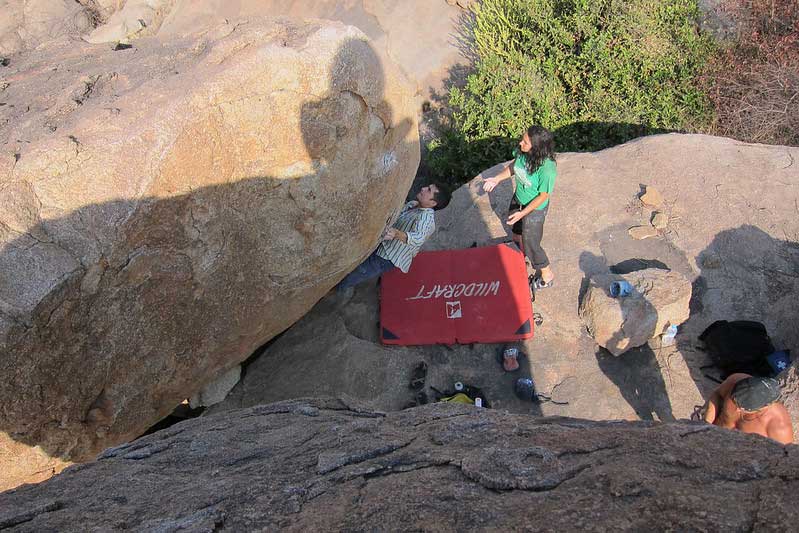
Pros of Bouldering
- More accessible – no training, license, or partner required
- Cheap – no fancy equipment required
- Bouldering is more social
Cons of Bouldering
- Strength required – bouldering is more strength based than climbing
- Getting down – you often have to downclimb in bouldering, which can be scary for a beginner
- Fewer gyms – bouldering is less popular making it more difficult to find a bouldering-specific gym
What is Rock Climbing?
Rock climbing is a sport where climbers ascent large rock formations or indoor climbing walls using protective equipment such as a harness and rope to make it to the top. When climbing, you need a partner to belay you, this makes it impossible to practice the sport alone unless one is free soloing.
Rock climbing routes have no height restrictions. Sometimes, rock formations are so tall they have to be done in multiple pitches. This is known as multi-pitch climbing.
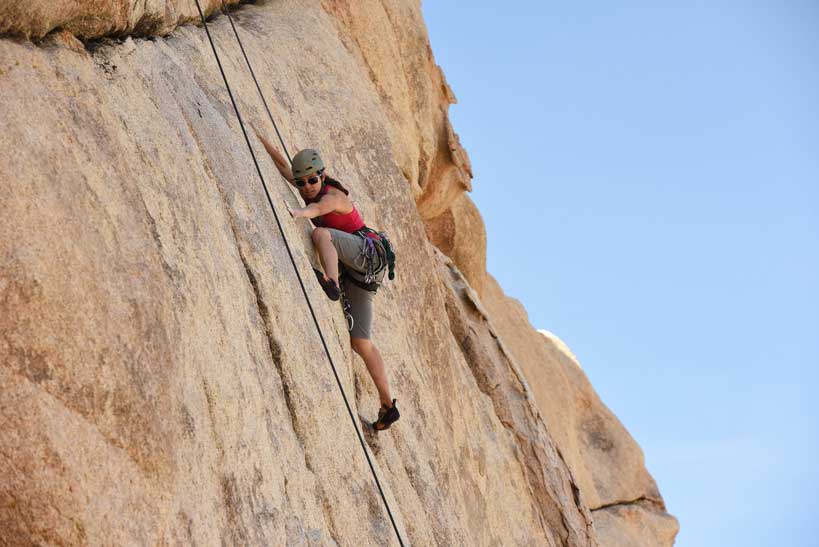
Pros of Climbing
- Satisfaction – sending a long route is more satisfying than sending a boulder problem
- Getting down is easy – as you are attached to a rope, your belayer will get you down safely
- More gyms available – oftentimes, its easier to find a local climbing wall than a bouldering gym
- Beginner-friendly – beginner climbing routes are easier than boulder problems
Cons of Climbing
- Requires a partner – you always need someone to belay you
- Requires training in belaying
- License required – some countries (especially in Europe) require licenses to climb, even indoors
- More expensive – there is more equipment to rent or purchase (harness, rope, belay device, quickdraws)
- Endurance required – routes are long so you need a lot of endurance for climbing
Bouldering vs Climbing – the Key Differences
Sport climbing is more endurance-heavy than bouldering
Endurance is where roped climbing and bouldering truly differ. Boulder problems are usually quite short meaning you only have to expend energy for a couple of moves and you get to rest a lot while projecting a boulder problem. This is not the case during sport or trad routes where the climber is expending energy for a longer period of time.
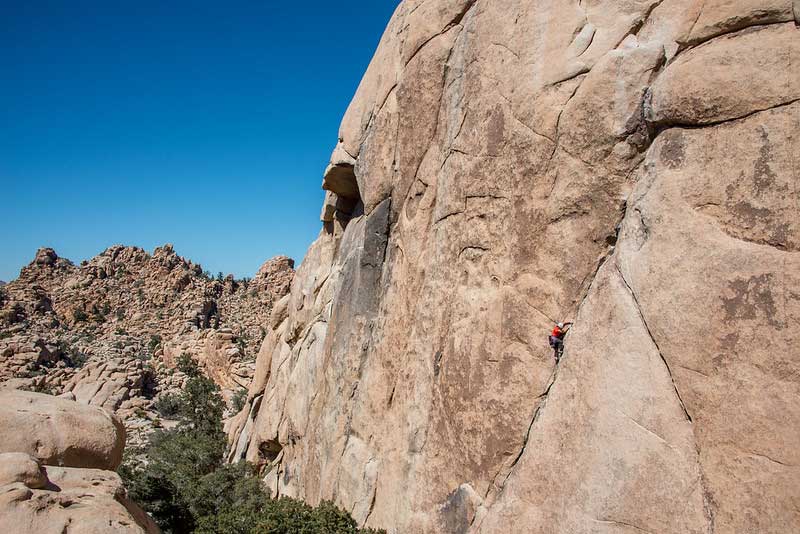
A typical boulder problem can be sent in less than a minute of climbing. A typical sport route on the other hand can take anywhere from 5 minutes to half an hour. Big wall climbs last even longer, these can take multiple hours and climbing is often split up into multiple days.
Bouldering is more strength-oriented than rock climbing
All forms of climbing obviously require strength but this is especially noticeable in bouldering where the increase in difficulty from one grade to the next often lies in the amount of strength you can output. Bouldering routes are shorter but much more intense than rock climbing routes.
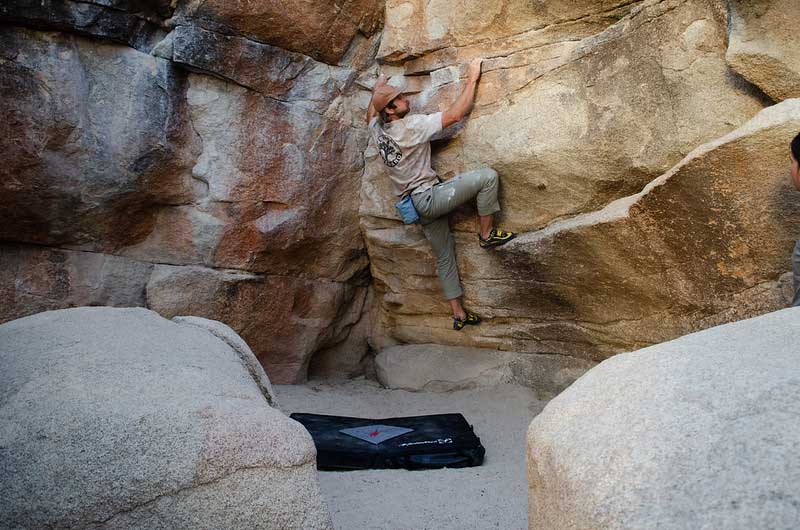
Different muscles are used between bouldering and rock climbing
Part of bouldering being more strenght-oriented and sport climbing being more endurance-oriented means there is a surprising difference in muscles being used between the two sports. While both are considered full body workouts, bouldering tends to require more upper-body strength compared to sport climbing which has a higher emphasis on core and leg-strength.
During bouldering shoulder-heavy moves such as mantles and gastons are much more common than they are in sport climbing. This is also why your average boulder specialist in the IFSC tends to look bulkier (especially in the upper-body) as compared to the average sport climbing specialist.
Bouldering and climbing use different grading systems
Both bouldering and sport climbing use entirely different grading systems.
The two common bouldering grading systems are Font (Europe, Asia) and the V-scale (North America).
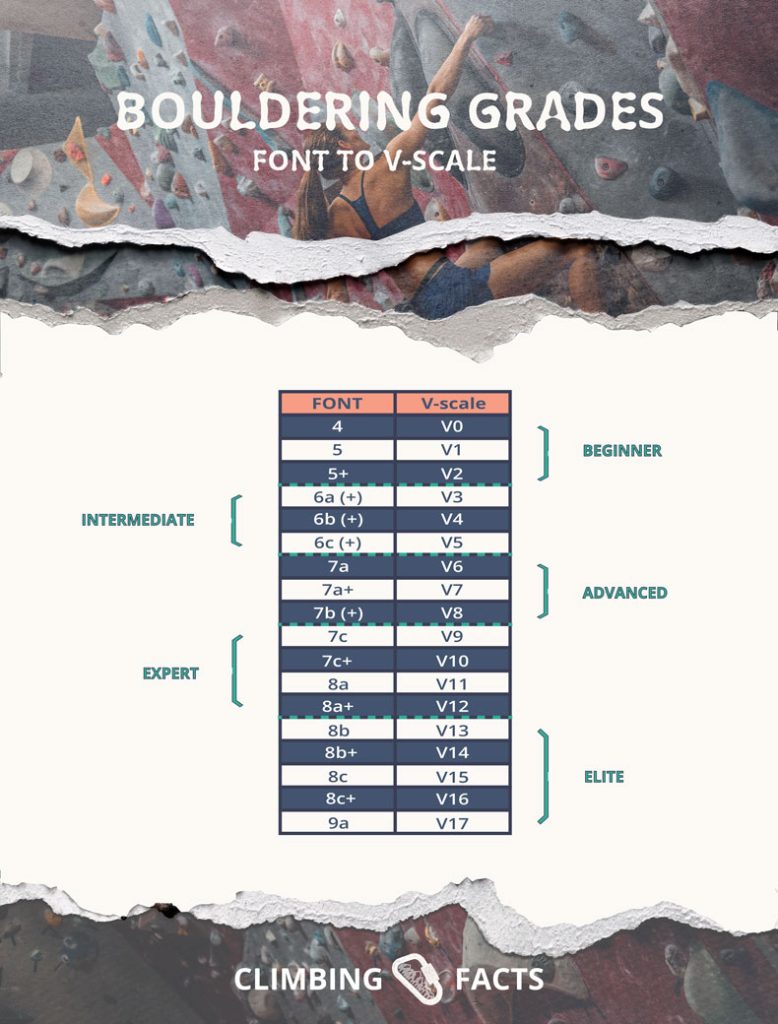
Whereas for sport climbing, the French scale is used in Europe, and the Yosemite Decimal System (YDS) is used in North America.
Bouldering vs Climbing – Which is the fit for you?
Some people may have come to this article to make the choice between bouldering or sport climbing. So let’s take a deep dive into their pros and cons!
Bouldering is more affordable than rock climbing
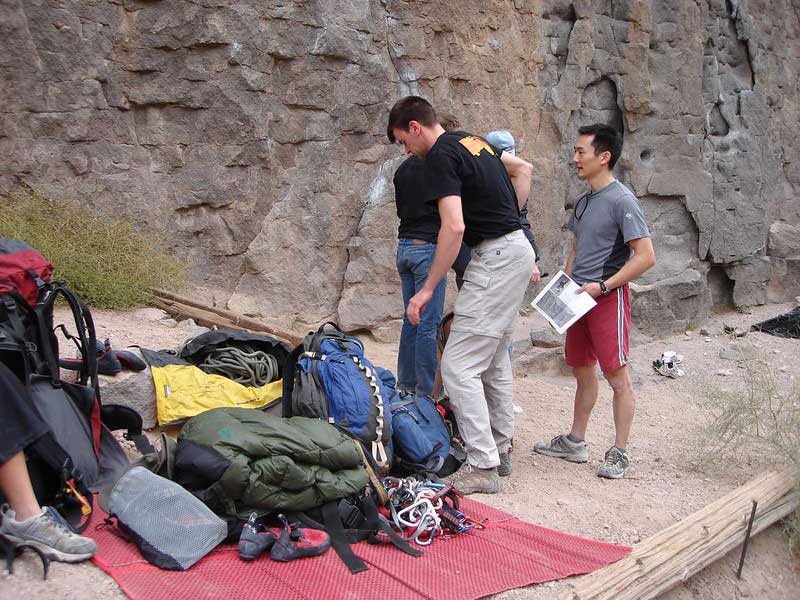
Boulderers only require climbing shoes, some chalk, and a crash pad to get around. Sport climbers have quite a bit more gear to purchase in comparison. Climbing harnes, ropes, belay devices, quickdraws, the list goes on. And then we haven’t even covered trad climbing another form of roped climbing, which is even more expensive.
Bouldering is more accessible than climbing
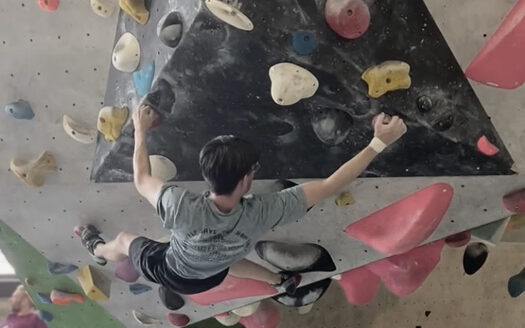
If you wish to start roped climbing, you are going to need a partner to belay you. This is not the case with bouldering. You don’t need a partner to visit an indoor bouldering gym!
This means you can partake in the sport of bouldering without having to convince a friend to tag along with you each time. If you’ve been wanting to get into climbing, indoor bouldering is the best choice as it is a solo activity.
Climbing is more beginner-friendly than bouldering
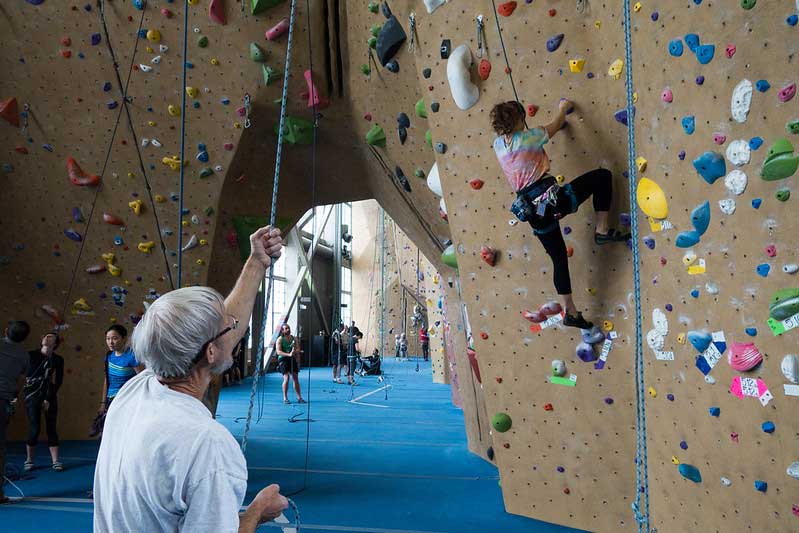
While bouldering is more accessible, climbing routes tend to be more beginner friendly. Top rope climbing routes are very straightforward and beginner routes tend to have really good holds. This makes it fun to start climbing as a complete beginner, even if you don’t have much strength or flexibility.
Boulder problems are not as straightforward as climbing routes which makes them a little more daunting. The whole point of bouldering is that you solve the problem using proper beta, meaning it takes a while to get used to the sport. You might get very confused on your first bouldering session, which is something that doesn’t really happen in climbing.
As a first-time boulderer, you are likely to struggle on the easy grades (V0, V1) for a while in climbing you will progress a bit faster.
Additionally, bouldering gyms are so accessible that you don’t need any information to get started. This might sound like it would make the sport more friendly for beginners but this actually has the opposite effect. Beginner boulderers often struggle to find the starting holds of a problem or struggle to solve beginner problems altogether.
During climbing, as a beginner, you always have someone keeping an eye out for safety reasons. This person will also be your contact person if you have any questions or struggle with a route. In bouldering, you are kind of left alone and have to approach strangers to get similar info.
Bouldering is more social than climbing
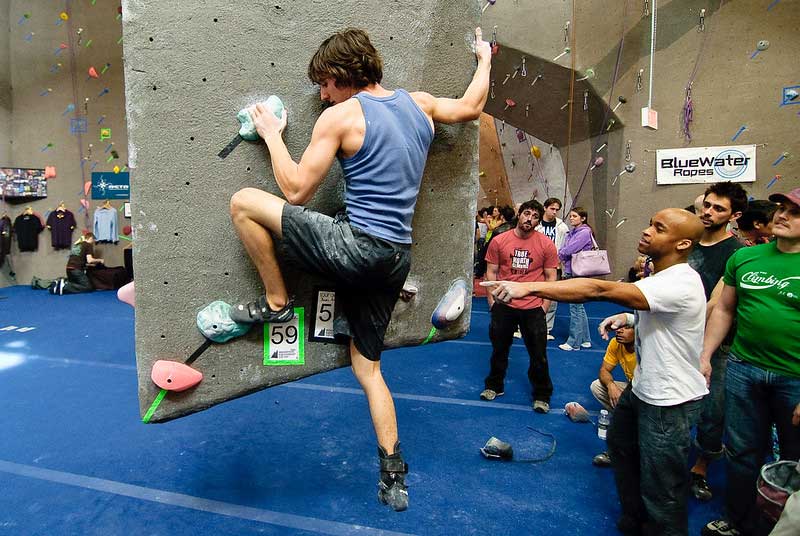
Climbing is a social sport in general so you really cannot go wrong with either but if you are looking to make friends in a new hobby or generally prefer a more social environment, bouldering gyms are the better option.
For starters, many boulderers go bouldering by themselves. This makes it more likely that they will approach other climbers or seek conversation. Climbers, on the other hand, arrive in pairs. They are less likely to socialize as they already have each other.
At bouldering gyms, climbers often attempt the same boulder problem. This can result in strangers giving each other tips and beta to send a problem. Approaching other boulderers about a specific problem is so common at a bouldering gym, I can’t remember the last time I went to a bouldering gym and didn’t get approached at least once.
Due to the nature of rope climbing gyms, everyone is busy on their own route and climbers are less likely to run into other climbers. So if you were hoping to join an extremely social sport, bouldering is likely the best choice.
Indoor Bouldering gyms vs Indoor Climbing gyms
Most people new to climbing will start climbing indoor first. (Or at least I hope so!) So I thought it would be good to compare indoor bouldering gyms with indoor climbing gyms! Let’s take a look…
Bouldering gyms have a higher capacity than climbing gyms
One thing that sport climbing gyms struggle with is that they are over capacity REALLY quickly. This is not something that boulderers have to deal with as much. Sure, both types of climbing gyms can get really busy during peak hours but at least you will get to climb if a bouldering hall is busy. During peak hours at a rope climbing gym, you will have to wait a long time. And if you aren’t assertive, you might not even get to climb at all.
Because boulder problems are so short, you will take turns with other boulderers when the gym gets busy. Rope climbs are very different. For each climbing route, you have to wait for 2 people to reach the top. This can take a while!
Waiting in line for a pair to finish a climbing route can take 10 – 20 minutes. Waiting in line for a boulder problem will never last longer than a couple of minutes at the very maximum. This is why I will always prefer bouldering gyms over climbing gyms during busy times.
Bouldering gyms are cheaper than climbing gyms
While this will largely depend on where you climb, I’ve found that climbing-only gyms tend to charge more than a bouldering-only gym. In addition, you’ll have to pay more for your rental products at a climbing gym as opposed to a bouldering gym. Aside from climbing shoes, you’ll need to rent a harness and a belay device for which they will charge extra.
In my area, spending a day at the bouldering gym as a beginner will set you back $14 ($11 for the daypass and $3 for climbing shoes). Whereas the climbing gym charges $18.50 ($12 daypass, $3.50 for shoes and $3 for harness/belay device)
Indoor bouldering walls are less high (and less scary) than climbing walls
Fear of heights is very common and one of the main reasons why many people would never enter a climbing gym. Being 60 feet up on an indoor climbing wall up can be very scary (even for people who don’t have fear of heights!)
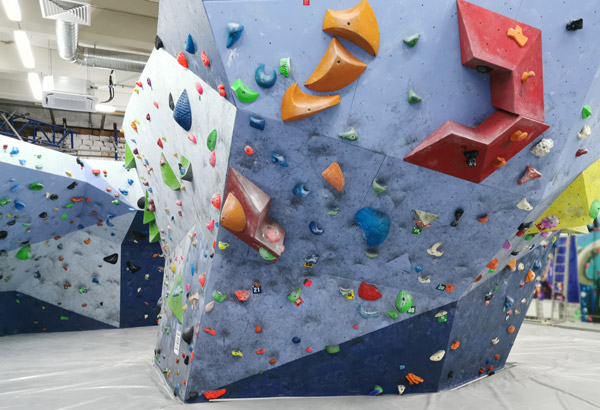
For these people, bouldering is the obvious choice. Bouldering walls are much less daunting. Most walls are up to 15 feet high and some bouldering gyms even have smaller walls that don’t exceed 10 feet. Bouldering gyms can be a great introduction to rock climbing for anyone who struggles with fear of heights.
Bouldering gyms have more variety as opposed to Climbing gyms
Bouldering gyms tend to have all styles of climbing. Vertical walls, steep walls, slabs, caves, every style of climbing is well represented at a bouldering gym. You can do old school climbs on small crimps in the overhang section or spend you time on a comp style problem on the slab wall. This isn’t the case for climbing walls which are very limited in their ability to mix things up.
In addition, boulder problems are more frequently changed than climbing routes. This is because it is much more expensive and time consuming to change up the holds on climbing walls compared to bouldering walls.
Conclusion
When making the comparison between indoor bouldering and indoor climbing, I favor bouldering by miles (as my lack of points for climbing gyms clearly shows). When it comes to outdoor climbing, I favour sport routes over outdoor boulders.
So why am I so in favor of one over the other? It’s simply that I consider indoor bouldering a sport on its own. In comparison, indoor climbing is something I see as practise for the outdoors. I enjoy it as well, but not in the same way.
Indoor bouldering offers more variety, more fun, requires no partner and has a better social scene. It mixes ‘practise’ with ‘fun’. Something I lack from indoor climbing walls.
So which should you start with?
I recommend you start with bouldering. Bouldering is much more accessible as you don’t need a partner to get started. But not only that, but you also don’t have to worry about learning how to belay someone.
I’ve found that the safety aspect of conventional climbing is what deters many from the sport. Many people want to start climbing, but because they have to take a little course beforehand, or because the walls are high, they tend to avoid the sport.
Bouldering has no such strings attached. If at any time you feel like going climbing, you can hit up a bouldering wall and get started. No information briefing, and no complications. All you will need is a pair of climbing shoes (which you can rent) and some chalk (which you can purchase).
Additionally, starting at bouldering makes it easier to transition into climbing compared to vice-versa. This is because bouldering is harder than climbing as problems require a solution as well as more strength and flexibility.